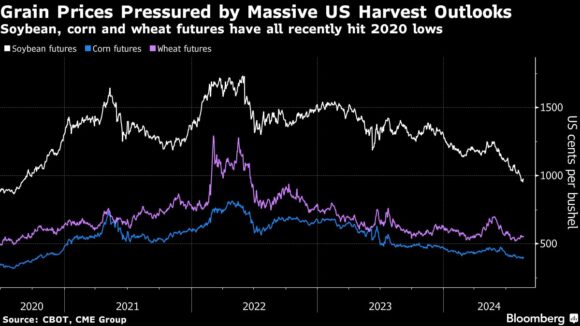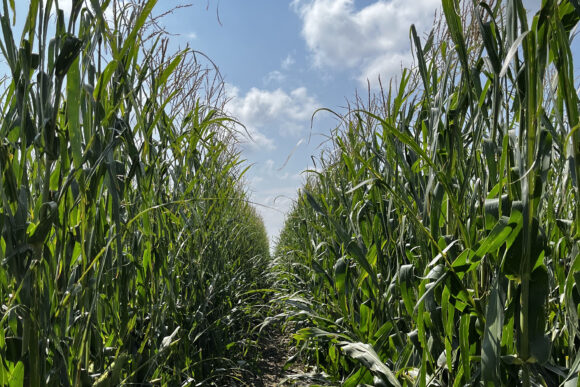Between hail, strong winds, floods and plant disease, US corn crops were put through some tough times this summer. But somehow, the fields of green blanketing America’s heartland have proved to be ever resilient.
Those are the findings heading into the final day of a Midwest tour that sends scouts traversing through the Crop Belt to measure yield potential. The scouts saw evidence of corn stalks with the tell-tale vibrant dark green leaves that typically signal plants will produce plump, starchy kernels of grain in the final stretches of the growing season. Soybean fields were also lush and healthy.
“There’s big yields out there, both corn and beans,” said Brian Grete, leader of the eastern leg of the Pro Farmer Crop Tour, which completes its four-day survey on Thursday.
Three days of data so far show that corn yields are looking better than the historical three-year averages in South Dakota, Ohio, Illinois and parts of Iowa. Soybean yields also look strong in many key growing areas. Final figures will be released late Thursday.
The findings buttress an outlook from the US Department of Agriculture, which is projecting record-large US corn and soybean yields this year. The croup tour provides the first “boots on the ground” look at fields, according to Chris Hawthorn, head of field crops section at USDA’s National Agricultural Statistics Service, and a scout on the tour. The agency did away with its own objective yield analysis — the physical counting of crops in the field — for the month of August back in 2019.
“Wearing my crop-tour hat, it looks amazing out there,” Hawthorn said. “Beans look really good and are reflective of what our numbers say.”
Ironically, many American farmers aren’t celebrating the bumper crops. Mega-harvests are creating a host of challenges, as the ample inventories pushed soybean and corn futures to the lowest since 2020 last week. Wheat futures also hit a four-year low late last month, with production set to be 9% higher than the prior year.
Farmers’ incomes are heading for a 26% slide this year, the biggest drop since 2006, forcing them to cut back on everything from fertilizer to equipment.
Weather is playing a significant role in the state-by-state outlook. Corn crops in parts of Iowa, Nebraska and South Dakota were damaged by hail, strong winds and floods. Storms also swept in pathogens that cause a corn disease called tar spot – evident by small, black spots on leaves. But ample rains throughout the growing season and mild summer temperatures benefited many fields in places like Indiana.
“One field looks like it’s ready to burn up and the next one is as green as a gourd,” said crop scout Mike Berdo, a farmer from Iowa.

David Benes, who helps manage 8,000 acres of farmland in Nebraska, said he expects his corn harvest to average as much as 240 bushels per acre, which is below his own record but above the average for past years. With the exception of a two-week dry spell in July, it was “almost an ideal year” with “adequate to good precipitation levels,” Benes said.
And “you can still add weight to those kernels,” he said, leaving further room for yields to improve before the harvest.
The crop tour is putting a spotlight on the problems farmers must face as grain prices stay depressed.
“You have to stop spending your money foolishly,” said Steve Zavadil, a Nebraska farmer who planted 300 acres with corn and 250 acres with soybeans this season. “You can’t be going out and buying any new equipment all the time. We’ve just got to adjust.”
While farm-machinery makers can lay off workers or sell businesses in lean times, grain growers’ best option usually is to maximize yields so they have more to sell even if prices are low. US farmers cut back on corn plantings this spring by 3% and boosted soybean sowings by the same amount. Timely rains and sunshine, with a relative lack of damaging heat during the peak growing season, were nearly ideal for crops.
“I suppose that’s just the way it is,” Zavadil said while observing scouts taking samples of his soybean and corn crops. “You know, big crop coming down the road, and everybody knows it — probably the best we’ve seen here.”
Photo: Corn field in Cedar County, Nebraska.Photographer: Gerson Freitas/Bloomberg
Topics USA Agribusiness
Was this article valuable?
Here are more articles you may enjoy.



 Markets/Coverages: Baltimore Bridge Collapse Sparks Port Blockage Cover From Marsh
Markets/Coverages: Baltimore Bridge Collapse Sparks Port Blockage Cover From Marsh  Racer Scott Bloomquist Remembered After Plane Crash in Tennessee
Racer Scott Bloomquist Remembered After Plane Crash in Tennessee  CIAB: Clear Evidence of Softening Commercial P/C Market Conditions in Q2
CIAB: Clear Evidence of Softening Commercial P/C Market Conditions in Q2  Taylor Swift Cancellations Deal Blow to Insurers: Sources
Taylor Swift Cancellations Deal Blow to Insurers: Sources 

